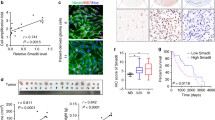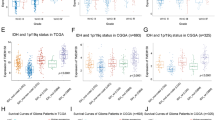Abstract
Mammalian sterile 20-like 1 (Mst1), an upstream serine/threonine-specific protein kinase of the Hippo pathway, is reported to play important roles in tumor suppression and organ size regulation in mammals via regulating cell proliferation and survival. However, whether it is involved in the pathogenesis of malignant gliomas remains poorly understood. Therefore, in the present work, we examined the effect and mechanism of Mst1 on the proliferation and apoptosis of malignant glioma cells. The cell proliferation and growth of glioma cells were examined by EdU incorporation and CCK-8 assay. In addition, the cell apoptosis was assessed by flow cytometry. We found that down-regulation of Mst1 promoted glioma cell proliferation and growth, but inhibited the cell apoptosis. Consistent with this, over-expression of Mst1 inhibited glioma cell proliferation and growth. Interestingly, Mst1 did not affect the phosphorylation of YAP1, the key downstream molecule of Hippo pathway. However, Mst1 was found to bind to AKT in glioma cell and negatively regulated AKT and mTOR activity. Finally, the increased cell proliferation rate induced by Mst1 down-regulation was partially abolished by down-regulation of AKT1. Meanwhile, glioma cell growth inhibition induced by Mst1 over-expression was partially rescued by over-expression of AKT1. Taken together, these findings suggest that Mst1 regulates proliferation of glioma cells via AKT/mTOR signaling pathway.





Similar content being viewed by others
Abbreviations
- Mst1:
-
Mammalian sterile 20-like 1
- YAP:
-
Yes-associated protein
- mTOR:
-
Mammalian target of rapamycin
- TAZ:
-
Transcriptional co-activator with PDZ-binding motif
References
Wen PY, Kesari S (2008) Malignant gliomas in adults. N Engl J Med 359(5):492–507
Huse JT, Phillips HS, Brennan CW (2011) Molecular subclassification of diffuse gliomas: seeing order in the chaos. Glia 59(8):1190–1199
Grossman SA, Ye X, Piantadosi S, Desideri S, Nabors LB, Rosenfeld M, Fisher J (2010) Survival of patients with newly diagnosed glioblastoma treated with radiation and temozolomide in research studies in the United States. Clin Cancer Res 16(8):2443–2449
Dan I, Watanabe NM, Kusumi A (2001) The Ste20 group kinases as regulators of MAP kinase cascades. Trends Cell Biol 11(5):220–230
Ahn SH, Cheung WL, Hsu JY, Diaz RL, Smith MM, Allis CD (2005) Sterile 20 kinase phosphorylates histone H2B at serine 10 during hydrogen peroxide-induced apoptosis in S. cerevisiae. Cell 120(1):25–36
Cheung WL, Ajiro K, Samejima K, Kloc M, Cheung P, Mizzen CA, Beeser A, Etkin LD, Chernoff J, Earnshaw WC, Allis CD (2003) Apoptotic phosphorylation of histone H2B is mediated by mammalian sterile twenty kinase. Cell 113(4):507–517
Lehtinen MK, Yuan Z, Boag PR, Yang Y, Villen J, Becker EB, DiBacco S, de la Iglesia N, Gygi S, Blackwell TK, Bonni A (2006) A conserved MST-FOXO signaling pathway mediates oxidative-stress responses and extends life span. Cell 125(5):987–1001
Yuan Z, Lehtinen MK, Merlo P, Villen J, Gygi S, Bonni A (2009) Regulation of neuronal cell death by MST1-FOXO1 signaling. J Biol Chem 284(17):11285–11292
Harvey KF, Pfleger CM, Hariharan IK (2003) The Drosophila Mst ortholog, hippo, restricts growth and cell proliferation and promotes apoptosis. Cell 114(4):457–467
Wu S, Huang J, Dong J, Pan D (2003) Hippo encodes a Ste-20 family protein kinase that restricts cell proliferation and promotes apoptosis in conjunction with salvador and warts. Cell 114(4):445–456
Huang J, Wu S, Barrera J, Matthews K, Pan D (2005) The Hippo signaling pathway coordinately regulates cell proliferation and apoptosis by inactivating Yorkie, the Drosophila Homolog of YAP. Cell 122(3):421–434
Dong J, Feldmann G, Huang J, Wu S, Zhang N, Comerford SA, Gayyed MF, Anders RA, Maitra A, Pan D (2007) Elucidation of a universal size-control mechanism in Drosophila and mammals. Cell 130(6):1120–1133
Zhao B, Wei X, Li W, Udan RS, Yang Q, Kim J, Xie J, Ikenoue T, Yu J, Li L, Zheng P, Ye K, Chinnaiyan A, Halder G, Lai ZC, Guan KL (2007) Inactivation of YAP oncoprotein by the Hippo pathway is involved in cell contact inhibition and tissue growth control. Genes Dev 21(21):2747–2761
Zhou D, Conrad C, Xia F, Park JS, Payer B, Yin Y, Lauwers GY, Thasler W, Lee JT, Avruch J, Bardeesy N (2009) Mst1 and Mst2 maintain hepatocyte quiescence and suppress hepatocellular carcinoma development through inactivation of the Yap1 oncogene. Cancer Cell 16(5):425–438
Ren A, Yan G, You B, Sun J (2008) Down-regulation of mammalian sterile 20-like kinase 1 by heat shock protein 70 mediates cisplatin resistance in prostate cancer cells. Cancer Res 68(7):2266–2274
Lin X, Cai F, Li X, Kong X, Xu C, Zuo X, Yang Q (2013) Prognostic significance of mammalian sterile 20-like kinase 1 in breast cancer. Tumour Biol 34(5):3239–3243
Cassinelli G, Zuco V, Gatti L, Lanzi C, Zaffaroni N, Colombo D, Perego P (2013) Targeting the AKT kinase to modulate survival, invasiveness and drug resistance of cancer cells. Curr Med Chem 20(15):1923–1945
Amornphimoltham P, Sriuranpong V, Patel V, Benavides F, Conti CJ, Sauk J, Sausville EA, Molinolo AA, Gutkind JS (2004) Persistent activation of the Akt pathway in head and neck squamous cell carcinoma: a potential target for UCN-01. Clin Cancer Res 10(12 Pt 1):4029–4037
Laplante M, Sabatini DM (2009) mTOR signaling at a glance. J Cell Sci 122(Pt 20):3589–3594
Akhavan D, Cloughesy TF, Mischel PS (2010) mTOR signaling in glioblastoma: lessons learned from bench to bedside. Neuro Oncol 12(8):882–889
Sami A, Karsy M (2013) Targeting the PI3 K/AKT/mTOR signaling pathway in glioblastoma: novel therapeutic agents and advances in understanding. Tumour Biol 34(4):1991–2002
Cinar B, Fang PK, Lutchman M, Di Vizio D, Adam RM, Pavlova N, Rubin MA, Yelick PC, Freeman MR (2007) The pro-apoptotic kinase Mst1 and its caspase cleavage products are direct inhibitors of Akt1. EMBO J 26(21):4523–4534
Yuan Z, Kim D, Shu S, Wu J, Guo J, Xiao L, Kaneko S, Coppola D, Cheng JQ (2010) Phosphoinositide 3-kinase/Akt inhibits MST1-mediated pro-apoptotic signaling through phosphorylation of threonine 120. J Biol Chem 285(6):3815–3824
Porter AG, Janicke RU (1999) Emerging roles of caspase-3 in apoptosis. Cell Death Differ 6(2):99–104
Tian HY, Li ZX, Li HY, Wang HJ, Zhu XW, Dou ZH (2013) Effects of 14 single herbs on the induction of caspase-3 in tumor cells: a brief review. Chin J Integr Med 19(8):636–640
Wurstle ML, Laussmann MA, Rehm M (2012) The central role of initiator caspase-9 in apoptosis signal transduction and the regulation of its activation and activity on the apoptosome. Exp Cell Res 318(11):1213–1220
Avruch J, Zhou D, Fitamant J, Bardeesy N (2011) Mst1/2 signalling to Yap: gatekeeper for liver size and tumour development. Br J Cancer 104(1):24–32
Hay N, Sonenberg N (2004) Upstream and downstream of mTOR. Genes Dev 18(16):1926–1945
Hahn-Windgassen A, Nogueira V, Chen CC, Skeen JE, Sonenberg N, Hay N (2005) Akt activates the mammalian target of rapamycin by regulating cellular ATP level and AMPK activity. J Biol Chem 280(37):32081–32089
Kwon Y, Vinayagam A, Sun X, Dephoure N, Gygi SP, Hong P, Perrimon N (2013) The Hippo signaling pathway interactome. Science 342(6159):737–740
Zhao B, Li L, Lei Q, Guan KL (2010) The Hippo–YAP pathway in organ size control and tumorigenesis: an updated version. Genes Dev 24(9):862–874
Piccolo S, Cordenonsi M, Dupont S (2013) Molecular pathways: YAP and TAZ take center stage in organ growth and tumorigenesis. Clin Cancer Res 19(18):4925–4930
Fernandez A, Northcott PA, Dalton J, Fraga C, Ellison D, Angers S, Taylor MD, Kenney AM (2009) YAP1 is amplified and up-regulated in hedgehog-associated medulloblastomas and mediates Sonic hedgehog-driven neural precursor proliferation. Genes Dev 23(23):2729–2741
Konsavage WM Jr, Kyler SL, Rennoll SA, Jin G, Yochum GS (2012) Wnt/beta-catenin signaling regulates Yes-associated protein (YAP) gene expression in colorectal carcinoma cells. J Biol Chem 287(15):11730–11739
Hay N (2005) The Akt-mTOR tango and its relevance to cancer. Cancer Cell 8(3):179–183
Shin SY, Lee KS, Choi YK, Lim HJ, Lee HG, Lim Y, Lee YH (2013) The antipsychotic agent chlorpromazine induces autophagic cell death by inhibiting the Akt/mTOR pathway in human U-87MG glioma cells. Carcinogenesis 34(9):2080–2089
Hassan B, Akcakanat A, Holder AM, Meric-Bernstam F (2013) Targeting the PI3-kinase/Akt/mTOR signaling pathway. Surg Oncol Clin N Am 22(4):641–664
Polivka J Jr, Janku F (2014) Molecular targets for cancer therapy in the PI3K/AKT/mTOR pathway. Pharmacol Ther 142(2):164–175
Yuan F, Xie Q, Wu JB, Bai YJ, Mao BB, Dong YL, Bi WZ, Ji GJ, Tao WF, Wang Y, Yuan ZQ (2011) MST1 promotes apoptosis through regulating Sirt1-dependent p53 deacetylation. J Biol Chem 286(9):6940–6945
Yustein JT, Xia L, Kahlenburg JM, Robinson D, Templeton D, Kung HJ (2003) Comparative studies of a new subfamily of human Ste20-like kinases: homodimerization, subcellular localization, and selective activation of MKK3 and p38. Oncogene 22(40):6129–6141
Ura S, Masuyama N, Graves JD, Gotoh Y (2001) MST1-JNK promotes apoptosis via caspase-dependent and independent pathways. Genes Cells 6(6):519–530
Coffey ET (2014) Nuclear and cytosolic JNK signalling in neurons. Nat Rev Neurosci 15(5):285–299
Sui X, Kong N, Ye L, Han W, Zhou J, Zhang Q, He C, Pan H (2014) p38 and JNK MAPK pathways control the balance of apoptosis and autophagy in response to chemotherapeutic agents. Cancer Lett 344(2):174–179
Acknowledgments
The research was supported by National Natural Science Foundation of China (No. 81272777; No. 81372699; No. 81302175); Natural Science Foundation of Jiangsu province (No. BK2011195); Natural Science Foundation of the Jiangsu Higher Education Institutions of China (No. 11KJB320019; No.13KJB320025).
Conflict of interest
The authors declare no conflict of interest.
Author information
Authors and Affiliations
Corresponding authors
Additional information
Y Chao and Y Wang contributed equally to this work.
Electronic supplementary material
Below is the link to the electronic supplementary material.
Rights and permissions
About this article
Cite this article
Chao, Y., Wang, Y., Liu, X. et al. Mst1 regulates glioma cell proliferation via the AKT/mTOR signaling pathway. J Neurooncol 121, 279–288 (2015). https://doi.org/10.1007/s11060-014-1654-4
Received:
Accepted:
Published:
Issue Date:
DOI: https://doi.org/10.1007/s11060-014-1654-4




